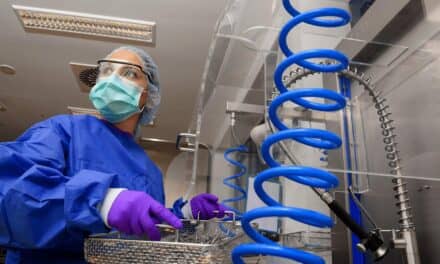
You possibly have enough in your lab to have it declared a “Superfund” site, but when you do clean it up, make sure that you follow the laws so that you do not appear as a news item: “Biomed Fined for Illegal Disposal of Hazardous Materials.” A good Web site to find information on how to dispose of these items correctly, as well as how to identify and eliminate suspect hazardous materials, is the Hospitals for a Healthy Environment site at www.h2e-online.org.
To address hazardous materials, hospitals have adopted the following sets of escalating precautions. The first, Standard Precautions, reduces the risk of the transmission of both body substances and blood-borne pathogens. These Standard Precautions are to be followed at all times. Hand washing—or the application of an approved antiseptic hand-rub medium—before entering or immediately after exiting a patient’s room, and before donning or after doffing gloves, is an industry standard. Masks or shields should be worn to protect mucous membranes. A gown may sometimes be needed.
Transmission-Based Precautions are those used with a patient who is suspected or is known to be infected or colonized with highly transmissible pathogens beyond which Standard Precautions can guard against. Transmission-Based Precautions are broken down into three categories, as follows:
• Contact Precautions: When contact with the patient may easily transmit a serious illness follow Standard Precautions. In addition, a sign will be placed at the entrance to the patient room indicating “Contact Precautions,” and the strict use of protective equipment will be required. Some examples of transmittable infections would be diphtheria, impetigo, scabies, or methacillin-resistant staph aureus. Some examples of viruses would be hepatitis A, respiratory syncytial virus, or para influenza. Patients with these infections or viruses will generally be in a private room, and the infection-control practitioner will know about the patient’s disposition.
• Droplet Precautions: When contact with body-fluid droplets from these patients may easily transmit a serious illness follow Standard Precautions. In addition, a sign will be placed at the entrance to the patient room indicating “Droplet Precautions,” and the strict use of protective equipment will again be required. The patient may not be in a private room, but must be at least 3 feet away from other patients or visitors. Some infections spread by droplets are pertussis and pneumonic plague. Some virus transmissions are flu, mumps, and rubella.
• Airborne Precautions: Respiratory contact with this patient will introduce airborne-droplet nuclei containing infectious material in the form of an evaporated medium containing infectious microorganisms that are suspended in the air for long periods of time. In addition to following Standard Precautions, a sign will be placed at the entrance to the patient room indicating “Airborne Precautions,” and the strict use of protective equipment will be required. The patient will be in a negative-pressure room, and the mask that must be worn is an N-95 respirator. Some illnesses associated with this type of transmission are measles, varicella, and tuberculosis. With this type of patient, the room should have negative pressure that keeps bacteria and spores from other patients. The air is generally run through a high-efficiency particulate air filter.
It is imperative that after leaving any patient’s room, regardless of the level of precaution, you disinfect the tools and equipment you used with a 10% bleach solution or similar phenolic disinfectant.
The next set of precautions to be recognized is Neutropenic Precautions. A sign to this effect must be in clear view at all times, no exceptions. This patient needs to be protected from you. Immuno-suppressed patients are at an extreme risk of infection from a variety of different avenues. In this situation, it is critical that you wash your hands (as stated above) and wear gloves, a gown, and a N-95 mask. You must disinfect the tools you will need before you enter the room, as well as after. Do not enter the room if you are sick in any way! These patients should be in a normal private room, unless any of the above mitigating factors exist.
Most of us have been in the “hot room” in the nuclear-medicine suite at one time. Here, “hot” does not mean the temperature in the room, but that the room contains radioactive material. Always ask the person in the room what is hot and what is not so that you do not touch something you shouldn’t. Most of the material there has a short half-life, meaning how long it takes the material to decay, or become safe.
Fuel rods from a nuclear power plant may have a half-life of 10,000 years, but the radioisotope used in a nuclear-medicine test may have a half-life of hours, or at most a few days. Minimize your exposure, and be careful of your surroundings. Do not touch or remove anything before you first test it for radioactivity. If you will be working in a hot room frequently, familiarize yourself with the survey meter (Geiger counter) and its proper operation.
As you move through the clinical labs, you will find all sorts of items that can cause problems, such as blood, body fluids,tissue, reagents, and chemicals. If you follow the posted warnings, you should be safe. If you smell chemicals, the lab probably has a ventilation problem or sloppy workers.
The morgue is another place where a biomed can be exposed to unknowns. This is especially true if the hospital morgue is also used by the medical examiner’s office. Airborne Precautions should be used in this area. Bone saws create a myriad of airborne particles, and you do not know who completed the terminal cleaning in this room, if at all.
In your shop, take some time to be sure that you have all the required documentation. Are the material safety data sheets (MSDS) readily available to you? Remember that the law states that the biomed shop must have a MSDS on any hazardous materials that are in the shop. A copy must be sent to whoever maintains the master list for the hospital so that emergency responders will be able to handle what is in the biomed shop if an incident occurs.
|
Who matches the inventory of materials to the MSDS? That is a question asked by the Joint Commission on Accreditation of Healthcare Organizations (JCAHO) or the Occupational Safety and Health Administration (OSHA) during inspections. Are they filed so they can be found quickly? Where are the backup MSDS sheets? What does the hospital or clinic emergency plan contain on the hazardous materials in the shop? The hospital emergency plan must include the items that are in the biomed shop, along with a statement on who to contact if there is a problem in the shop.
Do you even have an emergency plan for your shop? What about your disaster- or emergency-preparedness plan? What is your role if a hazardous spill or leak occurs? Running in the other direction is not the correct answer, even if that is what you want to do.
Fire safety is not something that many biomeds think much about, either. Do you even have a fire extinguisher in your shop? If so, make sure it is the correct one for any type of fire that you may encounter. Take a little time to memorize the different types of fires and what extinguishing media can be used on each one. Separate chemicals that have a compatibility problem, such as acids and bases. Keep all chemicals in approved containers, and store them in a safe location.
Remember, take the time to get your department in order, because when something happens, you need to respond correctly and quickly. Also, OSHA and JCAHO no longer announce their inspections, so you must be prepared at all times as you never know what is coming at you. 24×7
David Harrington, PhD, is director of staff development and training at Technology in Medicine (TiM), Holliston, Mass, and is a member of 24×7’s editorial advisory board.




